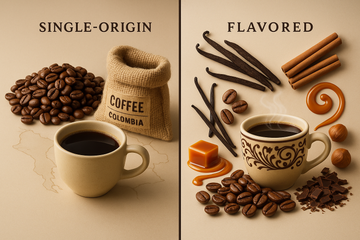Understanding the fundamental differences between pure single-origin coffees and artfully crafted flavored blends to enhance your coffee experience.
The world of coffee offers an incredible spectrum of flavors, aromas, and experiences, with two distinct categories standing at opposite ends of the spectrum: single-origin coffees and flavored coffee blends. Each approach represents a different philosophy in coffee craftsmanship, offering unique benefits and appealing to different palates and preferences.
Understanding Single-Origin Coffee
Single-origin coffee represents purity in its most authentic form. These coffees come from a specific geographic location, whether that's a particular farm, estate, or region within a coffee-growing country. The defining characteristic of single-origin coffee lies in its ability to showcase the unique terroir of its birthplace.
The concept of terroir encompasses everything that influences the coffee's flavor profile naturally: soil composition, altitude, climate patterns, rainfall, and even the specific processing methods used by local farmers. When you taste a single-origin coffee from the highlands of Ethiopia, you're experiencing flavors that cannot be replicated anywhere else in the world.
Characteristics of Single-Origin Coffee
Single-origin coffees typically exhibit distinct flavor profiles that reflect their geographic origins. Ethiopian coffees might showcase bright, floral notes with wine-like acidity, while Colombian beans often present balanced sweetness with chocolate undertones. Guatemalan coffees frequently display spicy complexity, and Jamaican Blue Mountain varieties are renowned for their mild, refined character.
These coffees undergo minimal processing beyond the essential steps of harvesting, processing, drying, and roasting. The roaster's skill lies in developing the beans to highlight their inherent characteristics rather than masking or altering them. This approach allows coffee enthusiasts to appreciate the subtle nuances that make each origin unique.
The Art of Flavored Coffee Blends
Flavored coffee blends represent a completely different approach to coffee craftsmanship. These creations combine carefully selected coffee beans with natural or artificial flavoring agents to create entirely new taste experiences. The process involves both the science of flavor chemistry and the artistry of balance and harmony.
Master blenders approach flavored coffee creation with the same precision that perfumers use when crafting fragrances. They must understand how different coffee bases will interact with various flavoring compounds, considering factors like roast level, bean density, and oil content. The goal is to create a harmonious marriage between the coffee's natural characteristics and the added flavors.
Popular Flavoring Approaches
Natural vanilla flavoring remains one of the most beloved additions to coffee blends. When expertly applied, vanilla enhances the coffee's natural sweetness while adding creamy, aromatic complexity. The key lies in achieving the right concentration – enough to provide noticeable enhancement without overwhelming the coffee's inherent character.
Caramel flavoring offers rich, buttery sweetness that complements medium to dark roast coffees particularly well. The caramelization notes in the flavoring echo the natural caramelization that occurs during the roasting process, creating layers of complementary sweetness and depth.
Floral notes, whether derived from jasmine, rose, or other botanical sources, create sophisticated and elegant flavor profiles. These delicate additions require exceptional skill to implement properly, as floral flavors can easily become overpowering or artificial-tasting if not carefully balanced.
Flavor Development and Processing Differences
The journey from green coffee bean to finished product varies significantly between single-origin and flavored varieties. Single-origin coffees rely entirely on the roasting process to develop their flavors. Roasters must understand the specific characteristics of each origin and adjust their roasting profiles accordingly to highlight the beans' best qualities.
Flavored coffee production involves additional steps in the process. After roasting, the beans are typically treated with flavoring oils or compounds while they're still warm, allowing for better absorption. Some producers use a tumbling process to ensure even distribution, while others employ specialized coating techniques.
The timing of flavor application is crucial. Adding flavoring too early in the process can result in flavor loss during roasting, while adding it too late may result in uneven distribution or poor absorption. Master blenders have developed precise protocols to ensure consistent results batch after batch.
Brewing Considerations and Techniques
Single-origin coffees often benefit from brewing methods that highlight their unique characteristics. Pour-over methods, French press, and other manual brewing techniques allow for precise control over extraction variables, enabling the full expression of the coffee's terroir. Water temperature, grind size, and brewing time can all be adjusted to optimize the extraction of specific flavor compounds.
Flavored coffee blends may require different brewing approaches to achieve optimal results. The added flavoring compounds can affect extraction rates and may benefit from slightly different brewing parameters. Some flavored coffees perform exceptionally well in automatic drip machines, while others shine when prepared as espresso-based beverages.
Quality Assessment and Selection Criteria
Evaluating single-origin coffees involves assessing their authenticity, processing quality, and how well they express their origin characteristics. Look for coffees that provide clear information about their source, including farm or cooperative names, processing methods, and harvest dates. The best single-origins will exhibit clean, distinct flavors that reflect their geographic origins without any off-notes or defects.
Quality flavored coffees require different evaluation criteria. The base coffee should still be of good quality, as poor-quality beans cannot be masked by flavoring. The flavoring itself should taste natural and well-integrated, enhancing rather than overwhelming the coffee's character. High-quality flavored blends will maintain their flavor consistency from the first sip to the last.
Making the Right Choice for Your Palate
The choice between single-origin and flavored coffee ultimately depends on your personal preferences and what you seek from your coffee experience. Single-origin coffees appeal to those who enjoy exploring the subtle differences between regions and appreciate the pure expression of coffee's natural flavors. These coffees reward careful attention and can provide an educational journey through the world's coffee-growing regions.
Flavored coffee blends offer accessibility and consistent enjoyment, particularly for those who prefer sweeter, more approachable flavors. They can serve as an excellent introduction to specialty coffee for those transitioning from heavily sweetened or flavored commercial beverages.
Consider your brewing habits, flavor preferences, and coffee-drinking occasions when making your selection. Many coffee enthusiasts find value in maintaining both types in their repertoire, choosing single-origins for contemplative morning rituals and flavored blends for afternoon treats or social occasions.
Both single-origin and flavored coffee blends represent valid expressions of coffee craftsmanship, each requiring skill, knowledge, and dedication to execute properly. Understanding their differences allows you to make informed choices and fully appreciate the artistry involved in creating exceptional coffee experiences.






